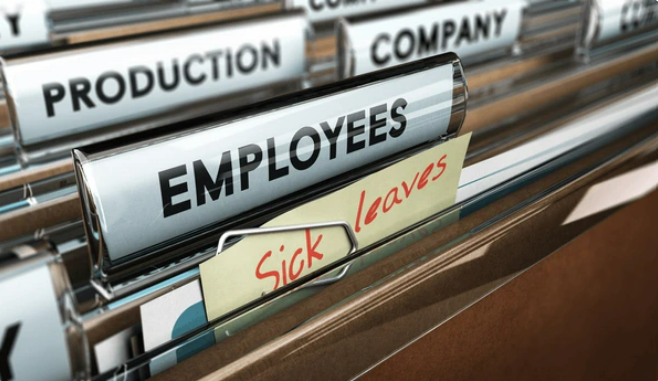✨ Health insurance, now in PayFit - learn more
💷 All the rates & thresholds you need to know for 25/26...right here
✨ The Payroll Journey: Start, Scale & Succeed Globally - learn more
✨ Health insurance, now in PayFit - learn more
💷 All the rates & thresholds you need to know for 25/26...right here
✨ The Payroll Journey: Start, Scale & Succeed Globally - learn more

When it comes to creating a paid sick leave policy in the UK, compassion and consistency are key ingredients.
Whether they’re battling a challenging illness or are buried under a pile of tissues bunged up with a cold, employees want to know they’ll be treated fairly while having a clear set of rules they can follow as they recover.
In this guide to UK paid sick leave, we’ll cover the essentials of statutory sick leave and pay while also discussing what should be included in your sick pay policy.
But first, let’s get back to some basics - when it comes to paid sick leave, what’s the law in the UK?
If an employee is ill in the UK, they can take time off work.
Employees can take up to 7 days off (including non-working days and bank holidays) without a sick note. But once they hit the 7-day mark, they must prove their illness to their employer with a sick note, more commonly known as a ‘fit note’. If your employee is late providing this document, then you don’t have to pay them SSP for any of the days it was late.
Fit notes are only acceptable if they come from a GP, doctor, or registered nurse, but occupational therapists, pharmacists and physiotherapists can also give these out.
A fit note usually says someone ‘isn’t fit for work’, but in some situations, they can say the employee ‘may be fit for work’. If this is the case, then you, as the employer, will need to figure out with your employee what ‘reasonable adjustments’ they might need to support their return to work. If you can’t agree on this, then the default is the employee is ‘not fit for work’.
While a fit note isn’t required for sick time of 7 days or less, the employee must confirm they’ve been ill to you when they return to work. Otherwise known as ‘self-certification’, this might consist of filling out a form or writing a more detailed explanation describing the illness.
Sometimes, sick leave might overlap with paid holiday an employee was planning to take. In this case, the employee should take the sick leave instead. If an employee doesn’t meet sick pay requirements, they should use their paid holiday instead to take time off. Remember, though, you can never force someone to take annual leave.
It’s also worth noting that employees can still accrue statutory holiday entitlement while they’re off sick. In other words, they can carry over any unused annual leave into the next holiday period.
When long-term sick leave extends beyond the normal timeframes, you might have to dismiss an employee based on illness.
Of course, it’s always best to avoid this scenario if you can. In other words, it’s important to at least try to make some adjustments so you can help them return to work. An occupational health assessment can help with this.
But this doesn’t always work out, and you might have to consider dismissing an employee because of their illness. While there are no ‘hard and fast’ rules here on when you should dismiss an employee, there are some helpful guidelines on Gov.UK.

When it comes to paid sick days in the UK, employees are entitled to 28 weeks of Statutory Sick Pay at a time. This can be taken straight through or as what we call ‘linked sickness’, meaning each sickness period is four or more days, and there is less than eight weeks between leaves. This can only last for up to 3 years before the employee loses their entitlement to SSP.
As for how many paid sick days an employee is allowed per year? Well, there’s no legal limit to this amount. It's up to your organisation what is and isn’t reasonable when limiting the amount of sick leave an employee can take.
To be eligible for Statutory Sick Pay (SSP), an employee must earn an average of at least £123 per week and have been ill for at least four days in a row (including non-working days). It does not matter if you they’re part-time or full-time. Through SSP, they’ll will receive the full amount of pay.
The rate of pay for standard sick leave is £109.40 a week for up to 28 weeks after the employee has been off for four days.
Learn more about how to calculate Statutory Sick Pay for your employees.
Your company’s paid sick leave policy is a vital part of your People strategy. Not only does it lay out the deal for workers when requesting time off from managers, but it also has an impact from a cultural perspective.
If your policy isn’t yet fair and consistent, then this should be a top priority for your HR team. A clear sickness and absence policy is one that sets out how to report an absence, what’s allowed and how to keep everyone in the loop.
At a minimum, a good sickness policy should look something like this:
Your company’s sickness policy, otherwise known as an Occupational Sick Pay scheme, should be crystal clear on who to tell when someone can't make it to work due to illness. Usually, it's the manager's call, but this doesn’t necessarily have to be the case. Employees should also have a clear understanding of how to self-certify sickness and set a deadline before they need a fit note. You’ll also want to outline which channels should be used for reporting.
As we covered a few sections before, if someone is off for up to 7 days, a self-certifying note is usually enough. You only need a fit note if the absence is over a week. You might choose to include some extra paperwork, like a statutory sick pay form (snag one for free here). This is entirely up to you. Juggling sick leaves for a big team can get tricky, but it's crucial for measuring productivity and growth.
Finally, there’s the return to work. As an employer, you should have a game plan for getting people back to work within your policy. Research says key factors for a smooth return are:
Personal competence
Workplace support
Social support from family and friends
Having some control over the job
In addition to this, holding a return-to-work interview can help suss out individual needs and figure out if any tweaks are needed.

Calculating annual leave for your staff
Last but certainly not least, having a solid sick leave and pay policy results in its fair share of benefits. It can:
Making sure there are clear rules for reporting absences and a solid return-to-work process ensures that employees get the right support to bounce back effectively.
A well-spelt-out absence and sickness policy not only keeps any chaos from employee absences in check but can also be a great boon to your productivity. Managers can organise coverage more efficiently, run a clear schedule and share the workload equally between team members.
When there are guidelines for giving notice, documenting stuff, and handling the return-to-work scene, everyone gets treated on the same level, leaving no room for confusion (or favourites).
Companies can nip unauthorised or excessive time off in the bud by laying out a clear procedure for reporting absences and asking for the right paperwork and medical proof up front.
Finally, a solid absence and sickness policy helps companies tick all the legal boxes. This includes providing adequate support to employees with disabilities, sticking to leave entitlements, and keeping a solid paperwork trail in order.
Managing sick leave plays a significant role in your employees' recovery, mental health, and productivity. And, as we’ve discovered, there are lots of ways to support your team's well-being and return to work.
Using HR software, like PayFit, makes this process even more breezy. Our platform is an excellent tool for managers and employees to easily record sick days, allowing you to ditch the paperwork-heavy processes.
And when it comes to threading this through payroll, PayFit payslips automatically update to reflect sick leave and pay, so employees are paid swiftly and accurately.
Now, everyone can get back to focusing on their jobs or recovering with a nice hot cup of soup!


What is the Statutory Sick Pay (SSP) rate in the UK, and how do you calculate SSP for all of your staff? This guide explains it all.

Our guide for UK employers & HR & Finance managers covers the essentials of statutory sickness pay & best practices for leave and absence management.

What are KIT and SPLIT days? Get clear guidance on employer responsibilities, employee rights, payment calculations, and managing a smooth return to work.

Occupational leave is a complicated subject in the UK. Get answers to your statutory sick pay (SSP) and occupational sick pay (OSP) questions here.

Calculate part-time holiday entitlement in 2025-2026. Learn about calculation methods, workers' rights, and recent legislative changes for UK employers.

Understand Statutory Sick Pay (SSP) with our complete guide for UK HR & Finance leaders, covering eligibility, rates, waiting days, forms & payroll processing.